25. April 2018

On the agile triangle (methods, structure, culture), one of the most difficult aspect remains that of cultural change; that is neither new nor surprising. What we call culture is a combination of many factors that cannot be grasped by causal thought and are therefore hard to influence by the usual methods of change management. Culture is not a thing that we change, it is something we live, that we bring to life by ourselves and our interaction with others.
There is a particular notion of the kind of person, or colleague, who we consider to be the basis of agile work methods, of work and life in agile organizations: it is usually a construct of young people from generation Y or Z. Structures that are more democratic, have a reduced hierarchy and are self-organized must be in touch with the life concepts of individuals if they are to work. It is no surprise that it has to be said: these »identities« are rare in the companies of today. Identities cannot easily be exchanged, it is not possible to simply adopt a new identity; yet we expect employees to do just that. In doing so, we experience that the models looking to a future of »new« work often fail to see the people performing in the companies.
We are facing the challenge of developing new identities for modern organizations. Not only companies can fulfil this task: in fact, it pertains to the social identity structures of our society.
Identity is rather a continuous process, in which people understand and design their life – in a psychological, social, political and philosophical dimension. A central aspect that touches on all dimensions is the understanding of work and the significance of work to the development of identity. This process is where we have to interject. That means that we need to address the significance of status, upward mobility, the meaning of life that is communicated through work in an accepted structure. Even where colleagues want to break down hierarchies today, their creation of identity cannot fit with the thought of a lateral career: they are attached to the expectation of hierarchical promotion and status gain.
As identity is a process, a negotiation between agents and by agents with structures, we can work on a process of identity for new organizational forms. This is where the boundary between work identity and social identity collapses; I can find the necessary conditions only in urban life designs.
As a process, it passes through several stadia. These include moments of confusion, judgemental comparisons with others, a tolerance for new forms of trying one’s own role, an acceptance of the new stage of identity, a development of pride and eventually the integration of the ‘work identity’ into the entire spectrum of the personal identity. It makes sense to describe this as a journey, which becomes easier when it is undertaken together with partners. It is probably necessary that these processes are accompanied. To achieve this, there are individual coachings as well as, especially, supervision concepts for groups. Looking for a way into this process, it is promising to address the topics of diversity and inclusion. Tackling these issues opens people up and lets them develop an openness for their own process of identity formation. At the same time, we must not overestimate the achievements that are available to a company in this process vis-a-vis dominant conditions and values. It will therefore be necessary to find people who are already on their way to living a different work identity.
Rüdiger Müngersdorff
20. April 2018
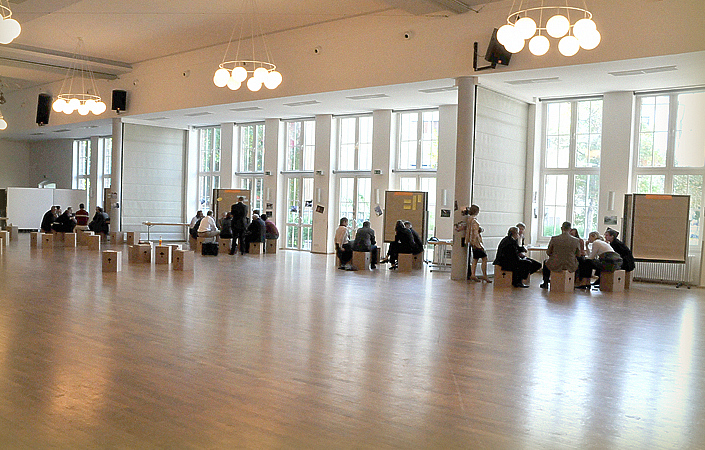
The group was silent. They stayed silent, even as the inviting manger tried to send an optimistic and constructive message. Questions were ignored or answered with vague and irrelevant responses. Although the conversation livened up a little in smaller groups, it still lacked clear statements that would have explained this highly unusual behaviour for a group in a work environment. I was faced with the remnants of a group, and an organization, in the aftermath of a failed agile experiment: silence, disappointment, sadness, discord. What had gone wrong?
It was not simply the manager’s doing. He had a very clear understanding of agile methods, agile forms of organizations and he clearly demonstrated that he had reflected on his position and his behaviour and was still doing so. Still, he had underestimated some of the social and psychological dynamics of his experiment.
Later on in the day, we were able to talk about a few of the reasons for the situation this organizational unit found itself in. This did not resolve the deep disappointment and loss of trust in oneself and the company, but it aided a more realistic appraisal. Which circumstances had been obstacles, where was the learning potential?
1. The project employed brilliant people with a good education, high commitment and a passionate pursuit of their ideas. They were to be different from the majority of the employees in this global, very well organized company. They were promised a place where they would be able to pursue their ideas, realize the projects that were closest to their hearts. The beginning was enthusiastic, teams emerged, the work was highly satisfactory. Then, however, the organization interfered with their own strategic notions. These often did not correspond with the dreams and hopes of the employees. Financing was discontinued from some projects – a logical and sensible step from the viewpoint of the company, yet a brutal stop for a new idea with a future which had seen great progress towards realization within a short time. The employees were neither able nor willing to understand the reasoning, and doubted the economic considerations. They were shifted into new projects, new beginnings: the essence of what had filled them with such a deep sense of meaning was gone. Although they were placed into an equally free and self-organized structure, it lacked the content, the emotional attraction. At this point, others left the company already. The mourning of lost projects was tangible during our workshop, it cast a long shadow over everything. However, it was not discussed, like a secret that everyone was aware of. Organizations that are characterized by their participants’ commitment and passion need farewells and rituals of mourning in order to free people up for something new, for a new passion. It is difficult to have a burning passion for a product idea in a context of dependent employment: working with people who want to be committed to facing problems, clients, possibilities seems to have more promise.
2. Following the textbooks, they nominated a Scrum Master, also a brilliant young man, with a lively, fluid intelligence and degrees from several top universities. He was good, but couldn’t put a halt to his own being the best of the best: he was unable to control his urge to be part of the actual work in every field by bringing in his knowledge, his ideas. He tried, quite dogmatically, to communicate the rules and demanded discipline. He lacked social skills, control of his narcissism and an understanding of the task and role of a methodic and social guide. He was the wrong man for this task. Social skills are rarely learnt at top universities.
3. The people were placed in an agile work context without a deeper understanding for the dynamics of an agile, self-organized structure. Their own psychological contract with the company, however, contains many elements that are not agile: these include an understanding of having become part of the system upon entry into the company, a system that takes care to provide a safe place and relieve any concerns about uncertainties of the future. They had entered a safety zone with the promise of a long career. The expected all the freedoms as well as a manager to provide a direction, carry the weight of decision-taking and provide a solution in cases of conflict. What they got was a general strategic direction, a discussion partner and someone who made sure that cooperation with the umbrella organization would work. They did not get any decisions on the content of their topic, their project. That in itself was too much. When it was then decided that the feedback talks would be conducted in the groups themselves, they were completely out of their depths. As no-one had any knowledge or experience of group dynamics, situations escalated and/or the system was paralysed by silence.
4. At first, all doubts, contradictions and uncertainties were compensated by the participants’ own enthusiasm for their own topics. As time went by and projects were lost, it had to be admitted that dreams were just illusions and questions arose: questions about the future, about security, questions that pop up once the buoyancy of enthusiasm is gone. Where careers, securities and rewards had initially been irrelevant, their significance now started to grow. A new importance was given to the future and to career paths. Promotion was the crux, and the notion of lateral careers only caused disappointment. A company that was unable to offer an upwardly mobile career became unattractive.
Following long periods of silence, we were able add up fragments of the pain and disappointments and at least establish a higher degree of truth. Scenarios for a new beginning were sketched out. For some, there emerged another opportunity to re-immerse themselves into an agile world with more understanding. Others gained the clear knowledge that agile self-organization was not the place for them. Some are leaving the organization – the headhunters are lying in wait. The clarity we gained made it possible for individuals to take decisions and forge a path on which to turn the lessons and experiences into a new attempt.
Clarity and the truth about agile organizations need to be told unmistakeably from the start. There has to be an understanding that the participants require a high degree of social competence in order for the journey to succeed. The position of an Agile Culture Coach should be a matter of course. And finally, we need to accept that we still have only few ideas when it comes to showing paths into the future for people in organizational structures of this kind: paths that can be an attractive alternative to the model of vertical careers.
Rüdiger Müngersdorff
6. February 2018
Together with the following endorsement of one of our trainings we were asked, what is the difference between a good leadership-training and a five-star training?
The answer is relatively simply – don’t elaborate on one of the uncountable leadership theories but give people the chance to reflect their current and future positions, create a space, where they can discover their own personality and emotional condition.
Or very simply: get personal.
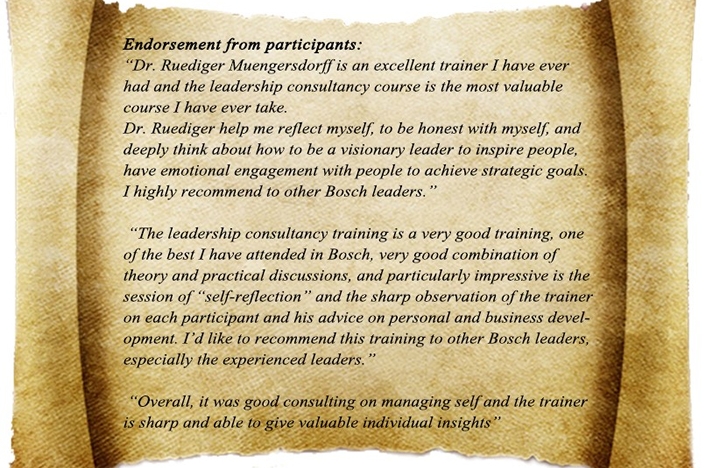
15. January 2018
 Among the employees and managers we meet who work in agile environments, more and more have recently asked us how to deal with dominant informal leaders. Both sociometry and group dynamics know informal leadership as a key phenomenon: it is a frequent cause of a range of social tensions in groups and teams.
Among the employees and managers we meet who work in agile environments, more and more have recently asked us how to deal with dominant informal leaders. Both sociometry and group dynamics know informal leadership as a key phenomenon: it is a frequent cause of a range of social tensions in groups and teams.
What we are talking about here are members of groups and organizations who have no other form of legitimation than their power of persuasion in groups. They dominate through their group behaviour. Their motivation to be dominant often has little to do with an advanced grasp of the matter at hand. Informal leadership would not pose a problem if it were enacted for the good of the matter. However, it often has negative side effects: loss of motivation, frustration and a reduced output among the other team members.
Self-organization is a highly challenging form of cooperation: it often lacks the regulatory function of a formal leader, or insecurities prevent that function from being perceived. As group-dynamic processes develop, the known side effects emerge: phenomena of stress, withdrawal by individuals, fights for dominance, and often the entire undertaking gets bogged down in the group’s dysfunctional type-casting. This is often the point where methodical purity is invoked. In a classic act of organizational thinking, the methods are further refined and bureaucratized.
However, it is a fallacy to believe that methodical purity can fix this problem. Rational rules can hardly grasp an emotional phenomenon and they can certainly not stage a sensible intervention. It takes emotionality in order to influence emotionality.
There is a good example for the negative effects of over-methodization. During the last years, we have been able to watch how Continuous Improvement approaches have lost their force and effect through over-methodization and over-regulation, stifling their original impulse to use a few simple methods in order to invite people to joyfully join in and participate. A restraining corset of methods will stifle such emotionally effective and important powers as passion, willingness to design and be self-effective.
All agile methods and forms of work contain a noticeable aspect of group dynamics through self-organization and the reduction of a formally powerful leadership role. These aspects contain much positive energy as long as the participants are involved, are given a common centre and are able to reflect on the power play within the group. As this often fails to happen, however, the group dynamics are allowed to unfold their negative effects. In order to work successfully, however, we need a joint deep understanding of social phenomena and a common language that helps us address them.
The specifications provide for an accompanier who is to watch over adherence to the methods. Yet, these accompaniers usually miss the necessary training and experience to be able to intervene in group dynamic phenomena. Agile coaches with the necessary experience of group dynamics can be of help here. That very experience, however, is often neglected in most trainings.
In order to be able to find a path to functioning self-organization, groups will require an accompanying experience to reflect what is happening to them and to others in groups. We now often engage in group coachings, working with groups who employ agile work methods or want to and should be working in agile ways. In theses sessions, even the reflection of just a few experiences within the group suffice to gain distance from some of the negative dynamics and thereby unlock the group’s potential.
An unreflected, dominant informal leadership makes potentially so very rich groups even poorer than single individuals can be. This loses us engagement, knowledge and ability. Therefore I issue here my plea for widespread group-dynamic learning in organizations as well as a warning to avoid an over-methodization of those forms of work that are based on emotional involvement.
Rüdiger Müngersdorff
3. January 2018
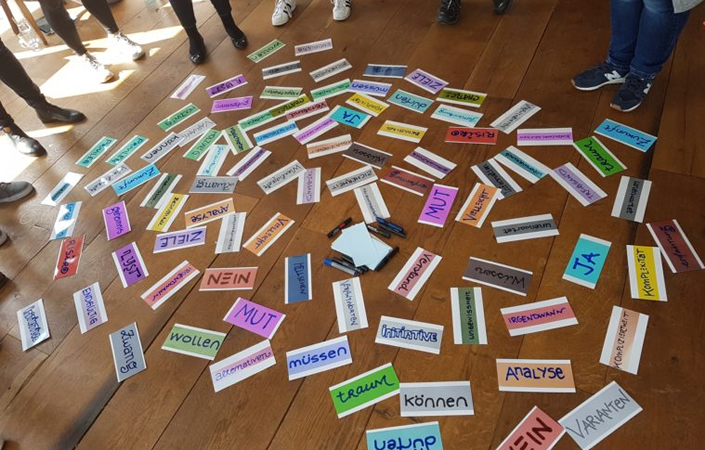
Does »Agility« and »Controlling« fit together? On the ICV ControllingBlog Hans-Peter Sander, Head of the ICV Team PR/New Media, tells about his Agile Culture Coach training that he completed in five modules in 2017 at SYNNECTA. Today: »Agile Teams and Collaboration«
If a company wants to be successful in the market, it needs creative, well-functioning employees. People work well when they enjoy doing it. For this they must find satisfaction in their actions. Above all, they need a meaningful job, a chance to work when and how much they want. And they need recognition from the community. For agile teams: The leadership must provide for appropriate conditions. Because agile work is by no means arbitrary, but has clear frames and orders. – How it all works, the Module IV of the Agile Culture Coach training informs, under the heading »Agile Teams and Collaboration«. Renate Standfest and Fetiye Sisko, both principals at SYNNECTA, both experienced female coaches, guide this elementary, exciting, instructive part of the training, as well as deep insights into the group of participants.
The starting point is the question how an »agile team« is composed, and which factors determine its success. Interesting discussions arise e.g from the outlined ideal of the »cross-functional« and »self-organized« team, in which a so-called »musketeer attitude« (»one for all – all for one!«) prevails, and in which the so-called »bus« factor applies (no head monopolies, pair programming) and work in the »T-Shaped Professionals«; Employees who combine the strengths of a generalist and a specialist.
Many exciting conversations in this workshop, based on Module III »Agile Methods and Scrum«, build the success factors of agile teams:
- Clearly defined job for the team
- Joint learning (for example dealing with a missing hierarchy)
- Role clarity, role uniqueness
- Impediments are identified but ignored
- Retros/Reviews not according to scheme F!
- Key skills: self-reflection, self-criticism, questioning everything!
- »Roles instead of jobs« (flat or no hierarchy, responsibilities)
Fuel for thought provides a lively discussion on the subject of »fundamental orders in social systems«. For example, what are the consequences if »affiliation takes precedence« (in the sense of: »every employee is equivalent«)? All members should be considered in important decisions; also difficult. And is the second »principle of temporal order« (»who is there longer, takes precedence«) not often violated in processes of change, by only favoring and praising what’s new?
The next principle, »Higher commitment takes precedence«, points in particular to the fact that leadership or executives must not be called into question; Managers, however, have to develop their position through greater commitment, leadership skills and behavior. And if the principle, »competence and achievement take precedence«, applies, special achievement, effectiveness, abilities should be shown; how can (power) conflicts arising from this be solved? The next principle, »acknowledging what is«, is to recognize realities that are no longer changeable: saving personal energy, letting go of the old helps to turn to something new. And finally, the principle of »giving and taking« has its deep meaning: where there is a balance between giving and taking, social relations can also harmonize.
Agility and conflicts
In this training module, a lot of place take up conflicts in an agile context. It starts with an interesting discussion on dealing with conflicts concerning culture: corporate, leadership or error culture. It’s intensively taught, as in all components of the training again with playful exercises, how to deal with conflicts within agile teams. The participants experience e.g. something about »systemic consensus«: Instead of using the sledgehammer approach »The stronger wins«, proceeding with the approach »What is important to us together?« and finding a solution. I noted an interesting quote: »The respect for a human being is shown in dealing with his No.«
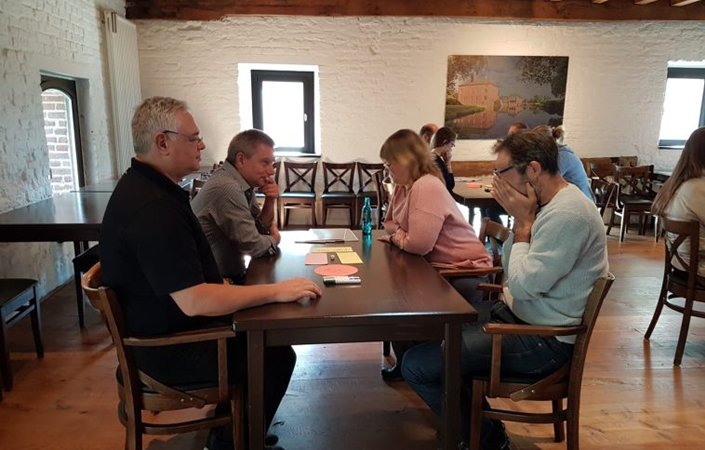
Finally, »Conflict Dojo« is a highlight on the first day of the seminar. In the playful conflict training, the players meet in small groups in several rounds on different character types and must deal with them: from a stubborn resistance through a conflict violent or a compassionate to a solution-seeker. (Picture: role playing at the »Conflict Dojo«)
Diversity: Elementary topic for successful agile teams
An important part of Module IV is »Diversity«. The seminar leaders convince with sensitivity that it is an elementary topic for successful agile teams. They succeed, like a simple-sounding and challenging task of everyday life, in recognizing commonalities and differences, preventing any discrimination, sensitizing them in different exercises. The seminar participants become familiar with creating the necessary transparency in taboo topics and getting to know formal as well as informal rules as well as tools for agile teams.
For example, while working with a »Diversity Insight Picture«, it is about the participants‘ reflection on diversity in themselves, but also in their experience, in the professional world as well as in the world as a whole. In organizations, this can be an analytical tool to explore needs in the context of business goals. It can help in the diversity strategy development and in the change of the corporate culture. In another exercise, the diversity lineup is tested: a highly emotional experience for some participants.
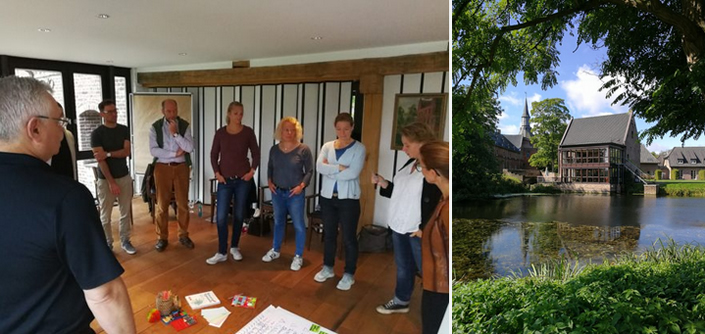
A weekend seminar with many group exercises – in picturesque surroundings, the Seminarhotel Schloss Wissen.
Hans-Peter Sander
blog.icv-controlling.com




 Among the employees and managers we meet who work in agile environments, more and more have recently asked us how to deal with dominant informal leaders. Both sociometry and group dynamics know informal leadership as a key phenomenon: it is a frequent cause of a range of social tensions in groups and teams.
Among the employees and managers we meet who work in agile environments, more and more have recently asked us how to deal with dominant informal leaders. Both sociometry and group dynamics know informal leadership as a key phenomenon: it is a frequent cause of a range of social tensions in groups and teams. 

